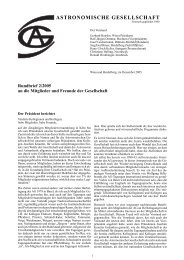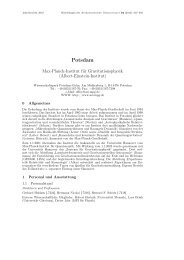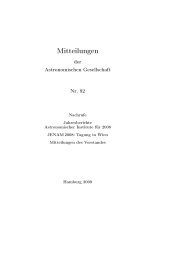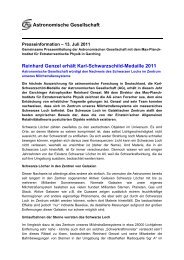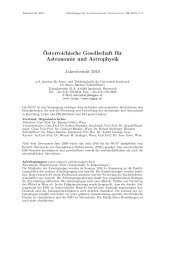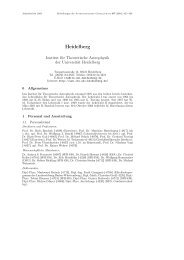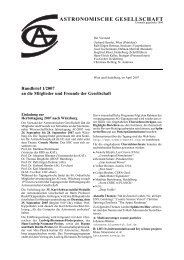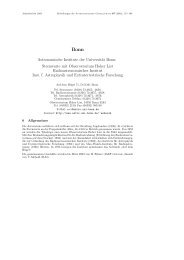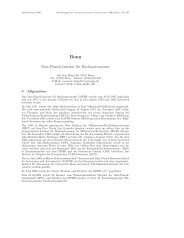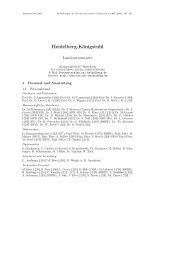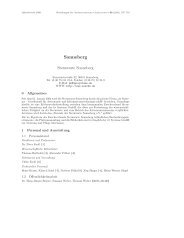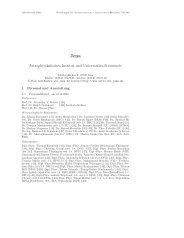Institut für Astronomie der Universität Wien - Astronomische ...
Institut für Astronomie der Universität Wien - Astronomische ...
Institut für Astronomie der Universität Wien - Astronomische ...
You also want an ePaper? Increase the reach of your titles
YUMPU automatically turns print PDFs into web optimized ePapers that Google loves.
Jahresbericht 2011 Mitteilungen <strong>der</strong> <strong>Astronomische</strong>n Gesellschaft 95 (2013), 667–685<br />
<strong>Wien</strong><br />
<strong>Institut</strong> <strong>für</strong> <strong>Astronomie</strong> <strong>der</strong> <strong>Universität</strong> <strong>Wien</strong><br />
1 Personal und Ausstattung<br />
1.1 Personalstand<br />
Professoren:<br />
Türkenschanzstraße 17, A-1180 <strong>Wien</strong><br />
Tel. (01)4277518 01<br />
(Vorwahl <strong>für</strong> <strong>Wien</strong> aus dem Ausland 00431)<br />
Telefax: (01)42779518<br />
e-Mail: vorname.nachname@univie.ac.at<br />
WWW: http://www.astro.univie.ac.at/<br />
J. Alves [-53810] (stv. <strong>Institut</strong>sleiter), M. Güdel [-53814] (<strong>Institut</strong>sleiter ab 1.10., davor<br />
stv. <strong>Institut</strong>sleiter), G. Hensler [-51895] (Dekan <strong>der</strong> Fakultät <strong>für</strong> Geowiss., Geographie und<br />
<strong>Astronomie</strong> ab 1.10.), B. Ziegler [-53825] (stv. <strong>Institut</strong>sleiter ab 1.10.)<br />
Ao. Professoren, <strong>Universität</strong>sdozenten, Assistenzprofessoren:<br />
Ao.Prof. E. Dorfi [51830], Ao.Prof. R. Dvorak [51840] (bis 30.9.), Ao.Prof. M.G. Firneis<br />
[51850] (Leiterin <strong>der</strong> Forschungsplattform ’Exolife’), Ass.Prof. J. Hron [51855], Ao.Prof. F.<br />
Kerschbaum [51856] (<strong>Institut</strong>sleiter bis 30.9.), Ao.Prof. M.J. Stift [51835], Ao.Prof. W.W.<br />
Zeilinger [51865]<br />
Wissenschaftliche Vertragsbedienstete und AssistentInnen:<br />
I. Brott [53817] (ab 4.1.), H. Dannerbauer [53826] (ab 1.9.), U. Kuchner (ab 1.11.), A.<br />
Liebhart [53816], Ch. Maier [53827] (ab 1.10.), Th. Posch [53800], S. Recchi [51897], E.<br />
Schäfer [51832], P. S. Teixeira [53813] (ab 1.10.), S. Unterguggenberger [53828], P. Woitke<br />
[53815] (ab 24.1.)<br />
Emeritiert bzw. im Ruhestand:<br />
Prof. M. Breger, Ao.Prof. R. Dvorak (seit 1.10.), Prof. P. Jackson, Ao.Prof. H.M. Maitzen,<br />
Prof. K. Rakos, A. Schnell, Ao.Prof. W. Weiss<br />
Nichtwissenschaftlicher Dienst:<br />
O. Beck [51814], ADir M.H. Fischer [53805], M. Hawlan [51801], J. Höfinger [51802], L.<br />
Horky [51811], S. Müller [51814], A. Omann [51823], K. Pöltner [51801] (Lehrling), F.<br />
Szabo [53806] (Lehrling), AR P. Wachtler [51815]<br />
Postdocs:<br />
B. Castanheira-Endl (bis 31.12), O. Czoske (bmwf: ESO-Inkind), B. Funk (1.11. bis 31.12.),<br />
Univ. Doz. G. Handler (bis 14.2.), Univ. Doz. G. Houdek, R. Kuschnig, Univ. Doz. Th.<br />
Lebzelter (bis 30.6.), P. Lenz (9.5. bis 8.6.), Th. Lüftinger (bis 31.10.), N. Mitchell, W.<br />
Nowotny-Schipper, Univ. Doz. E. Paunzen, E. Pilat-Lohinger, Ch. Reimers, A. Ruzicka
668 <strong>Wien</strong>: <strong>Institut</strong> <strong>für</strong> <strong>Astronomie</strong><br />
(bis 31.8.), R. Schwarz (15.2. bis 14.4.), R. Smolec (bis 14.10.), S. Uttenthaler (ab 1.1.), E.<br />
Vorobiev (ab 1.3.), K. Zwintz (APART-Stipendium)<br />
An<strong>der</strong>e Mitarbeiter und Stipendien:<br />
V. Antoci (bis 30.6.), A. Baier (DOC-fForte, bis 31.12.), V. Baumgartner (DOC-fForte,<br />
1.7. bis 31.12.), S. Eggl (FWF) (bis 31.12.), V. Fritz (Stipendium, bis 31.12.), M. Gold<br />
(Forschungsplattform ’Exolife’), E. Guggenberger, M. Gyergyovits (FWF), M. Hareter<br />
(FWF), A. Kaiser, S. Karrer (Stipendium, bis 30.6, von 1.9.), D. Klotz (FWF), M.T.<br />
Le<strong>der</strong>er (Österr. Akad. <strong>der</strong> Wiss., DOC-Programm), H. Leibinger (bis 31.8.), J. Leitner<br />
(Lehrbeauftragter am Inst. und wiss. Mitarbeiter <strong>der</strong> Forschungsplattform ’Exolife’), D.<br />
Lorenz (FWF)(15.2 bis 14.8.), A. Luntzer, A. Mayer (ab 1.11.), S. Meingast (bis 14.6.), M.<br />
Netopil (MOEL Stipendien <strong>der</strong> ÖFG <strong>für</strong> Masaryk <strong>Universität</strong> (Tschechische Republik)),<br />
C. Paladini (FWF), M. Petrov (1.1. bis 28.2.), S. Plöckinger (DFG), M. Rode-Paunzen (bis<br />
31.8.), B. San<strong>der</strong> (bis 31.12.), V. Schmid (FWF) (bis 30.6.), N. Themessl (Stipendium, bis<br />
30.6.), C. Turse (Forschungsplattform ’Exolife’)<br />
Tutoren:<br />
G. Bauer, M. Gold, A. Hren, N. Lampichler, G. Lochmann, A. Luntzer, A. Mayer, M.<br />
Mecina, S. Meingast, J. Nendwich, V. M. Passegger, H.-L. Pfau, H. Pomper, C. Raab, F.<br />
Ragossnig, V. Schmid, D. Steiner, M. Sundl, C. Vogl<br />
Doktorandenstellen im Rahmen eines Initiativkollegs:<br />
Das Doktorandenkolleg zur Planetologie wurde von R. Dvorak gemeinsam mit Prof. Köberl<br />
(Department <strong>für</strong> Lithosphärenforschung) weitergeführt. In diesem Rahmen wurden<br />
Untersuchungen zur Gefahr von Kollisionen von Near Earth Asteroids mit <strong>der</strong> Erde durchgeführt.<br />
Zwei Doktoranden sind dabei dem <strong>Institut</strong> <strong>für</strong> <strong>Astronomie</strong> zugeordnet: Akos Baszo<br />
sowie Mattia Galiazzo.<br />
Das Doktorandenkolleg zum Kosmischen Materiekreislauf wurde weitergeführt und zum<br />
Abschluss gebracht (Sprecher: G. Hensler).<br />
1.2 Instrumente und Rechenanlagen<br />
Leopold-Figl-Observatorium <strong>für</strong> Astrophysik (FOA):<br />
Der Betrieb <strong>der</strong> Außenstation erfolgte routinemäßig mit allen notwendigen Wartungsarbeiten<br />
(Schäfer, Zeilinger und technischer Dienst). Der Remote-Beobachtungsbetrieb des<br />
1.5m-Teleskops von <strong>Wien</strong> aus konnte erfolgreich fortgesetzt werden. Die dabei gewonnenen<br />
Erfahrungen konnten zur Optimierung <strong>der</strong> Teleskopsteuerung genutzt werden. Die Erfassung<br />
von meteorologischen Daten sowohl im Außenbreich als auch im Gebäude wurde<br />
weiter ausgebaut.<br />
Schwerpunkt <strong>der</strong> Beobachtungsprogramme am 1.5m-Teleskop war die Vorbereitung zu<br />
Follow-up Beobachtungen <strong>der</strong> GAIA-Mission und astrometrische Tests fï¿ 1<br />
2r das GAIA<br />
Ground-Based Optical Tracking Projekt. Des Weiteren wurden photometrische Beobachtungen<br />
von Kleinplaneten durchgeführt.<br />
Der Hauptspiegel des 0.6m-Teleskops wurde neu aluminisiert. Mehr als 300 Personen frequentierten<br />
die die öffentlichen Veranstaltungen des Observatoriums.<br />
Das 80cm-Nordkuppelteleskop und das Radioteleskop <strong>für</strong> die Lehre wurden routinemäßig<br />
weiter betrieben.<br />
Satelliten-Bodenstation:<br />
Die Satelliten-Bodenstation wurde bis 28.9. routinemäßig weiter betrieben. Am 28.9. wurde<br />
<strong>der</strong> Innenteil <strong>der</strong> Anlage durch einen Kabelbrand in <strong>der</strong> Mauer stark beschädigt. Die<br />
Renovierungsarbeiten ziehen sich bis ins Jahr 2012. Daher war die Bodenstation bis zum<br />
Jahresende 2011 nicht in Betrieb.
<strong>Wien</strong>: <strong>Institut</strong> <strong>für</strong> <strong>Astronomie</strong> 669<br />
1.3 Gebäude und Bibliothek<br />
Für die Bibliothek wurden 221 Druckschriftenbände neu angeschafft. 74 Zeitschriftenabonnements<br />
wurden fortgeführt. Es wurde mit einer Neuordnung und Inventarisierung<br />
des <strong>Institut</strong>sarchivs begonnen; beson<strong>der</strong>s wichtige unter den z.T. mehr als 200 Jahre alten<br />
Dokumenten des <strong>Institut</strong>sarchivs wurden digitalisiert und transkribiert.<br />
2 Gäste<br />
Gäste am <strong>Institut</strong>, zum Teil mit Vortrag im Kolloquium o<strong>der</strong> Seminar:<br />
G. Alecian, Meudon; A. Boehm, Innsbruck; T. Bountis, Patras; M. Casali, ESO; G. Chincarini,<br />
Milano; A. Crida, Nice; H. Dannerbauer, CEA Saclay; B. de Vries, KU Leuven;<br />
G. della Vedova, Mailand; M. Dunham, Yale; K. Eriksson, Uppsala; S. Ferraz-Mello, Sao<br />
Paulo; K. Hambleton, Lancashire; Chr. Helling, St. Andrews; Th. Henning, MPIA Heidelberg;<br />
G. Horneck, DLR; C. Hoyos, Nottingham; N. Jalti, Paris; J. Janik, Brünn; A. Juhasz,<br />
Sternwarte Leiden; I. Kamp, Groningen; M. Kissler-Patig, ESO; J. Klacka, Bratislava; W.<br />
Kley, Tübingen; R. Kochhar, IAU Comm. 41; J. Kurk, MPE Garching; P. Lenz, Warschau<br />
(mehrmals); W. Lin, Shanghai; M. Lombardi, Mailand; C. Maier, Zürich; L. Mattsson,<br />
Kopenhagen; W. O’Mullane, ESA; P. Papa<strong>der</strong>os, Porto; G. Parmentier, Bonn; Y. Peng,<br />
ETH Zürich; M. Petr-Gotzens, ESO; N. Polosukhina, Krim; S. Ramsay, ESO; M. Ratheiser,<br />
<strong>Wien</strong>; T. Ray, Dublin; J. Rove, San Jose, USA; T. Ryabchikova, Moskau (mehrmals);<br />
S. Sacuto, Uppsala; P. Salucci, SISSA-Triest; S. Sanchez, IAA-MPIA; D. Schulze-Makuch,<br />
Washington; M. Seidl, Innsbruck; D. Semenov, MPIA Heidelberg; I. Stoklasova, Ondrejov;<br />
A. Süli, Budapest; D. Suoami, Paris (mehrmals); K.-V. Tran, Zürich; S. Tschannett, <strong>Wien</strong>;<br />
M. Westmoquette, ESO Garching; D. Wilman, München; M. Wittkowski, ESO Garching;<br />
S. Wolf, Kiel; J. Zboril, Tatranska Lomnica; M. Zejda , Brünn; V. Zejdova, Brünn; R.<br />
Zhao-Geisler, Heidelberg; L.-Y. Zhou, Nanjing, China (mehrmals)<br />
3 Lehrtätigkeit, Prüfungen und Gremientätigkeit<br />
3.1 Lehrtätigkeiten<br />
Lehrveranstaltungen <strong>für</strong> das Bakkalaureats-, Magister- und Doktoratsstudium <strong>der</strong> <strong>Astronomie</strong><br />
wurden im üblichen Rahmen abgehalten. Als Gastprofessorinnen trugen im Sommersemester<br />
Christiane Helling (St. Andrews) über “Braune Zwerge und ihre Atmosphären”<br />
und im darauffolgenden Wintersemester Inga Kamp (Groningen) über “Star and Planet<br />
Formation” vor.<br />
3.2 Prüfungen<br />
Es erfolgten Prüfungen <strong>für</strong> drei Doktorats-Abschlüsse und drei Diplom-Abschlüsse.<br />
3.3 Gremientätigkeit<br />
J. Alves: Stellv. Leiter des <strong>Institut</strong>s<br />
M. Breger: Korrespondierendes Mitglied und Obmann <strong>der</strong> Kommission <strong>für</strong> <strong>Astronomie</strong> <strong>der</strong><br />
Österreichischen Akademie <strong>der</strong> Wissenschaften; Repräsentant Österreichs beim Editorial<br />
Board von Astronomy & Astrophysics; Astronomy & Astrophysics Editorial Board Executive;<br />
BRITE-Constellation Science Team: Scientific Executive; Hungarian Academy of<br />
Sciences Advisory Board Member; Hg. <strong>der</strong> Zeitschrift “Communications in Asteroseismology<br />
(CoAst)<br />
E. Dorfi: Vizestudienprogammleiter, Doktoratsvizestudienprogrammleiter; Studienkommision,<br />
Curricularkommission <strong>für</strong> Geowissenschaften, Geographie und <strong>Astronomie</strong><br />
R. Dvorak: Extrasolar Planets Road Map Advisory Team (EPRAT, ESA); CoI des CoRoT<br />
Teams (Planets); Assoc. editor <strong>der</strong> internationalen wissenschaftlichen Zeitschrift, Celestial<br />
Mechanics and Dynamical Astronomy (ADS: CeMDA)
670 <strong>Wien</strong>: <strong>Institut</strong> <strong>für</strong> <strong>Astronomie</strong><br />
M. G. Firneis: Kommission <strong>für</strong> <strong>Astronomie</strong> <strong>der</strong> Österreichischen Akademie <strong>der</strong> Wissenschaften;<br />
Beirat (<strong>Astronomie</strong>) <strong>der</strong> Österreichischen Gesellschaft <strong>für</strong> Wissenschaftsgeschichte;<br />
Studienkommision, Curricularkommission <strong>für</strong> Geowissenschaften, Geographie und<br />
<strong>Astronomie</strong><br />
M. Güdel: Leiter des <strong>Institut</strong>s (ab 1.10.); Präsident <strong>der</strong> Österreichischen Gesellschaft <strong>für</strong><br />
<strong>Astronomie</strong> und Astrophysik (ÖGA 2 ); Mitglied <strong>der</strong> Studienkonferenz; Mitglied <strong>der</strong> Fakultätskonferenz;<br />
Mitglied <strong>der</strong> Kommission <strong>für</strong> <strong>Astronomie</strong> <strong>der</strong> Österr. Akademie <strong>der</strong> Wissenschaften;<br />
assoziiertes Mitglied des Departements <strong>für</strong> Physik <strong>der</strong> ETH Zürich; Mitglied<br />
im Europäischen MIRI/JWST-Konsortium, im Spica/SAFARI-Konsortium, im PLATO-<br />
Konsortium, Science Associate <strong>für</strong> das EChO-Projekt (ESA); Mitglied <strong>der</strong> XMM-Newton<br />
Users Group<br />
G. Handler: Präsident des Kommission 27 <strong>der</strong> IAU<br />
G. Hensler: Vizedekan (bis 30.9.) bzw. Dekan (ab 1.10.) <strong>der</strong> Fakultät <strong>für</strong> Geowissenschaften,<br />
Geographie und <strong>Astronomie</strong><br />
J. Hron: Mitglied ESO-STC und ESO-ESE, ESO-Arbeitsgruppe <strong>der</strong> ÖGA 2 , European<br />
Interferometry Initiative Science Council, Fizeau Program Selection Committe (Chair),<br />
Science Teams VSI und MATISSE, Org. Comm. IAU Working Group on Abundances in<br />
Red Giants<br />
F. Kerschbaum: Leiter des <strong>Institut</strong>s (bis 30.9.); Fakultätskuriensprecher, Fakultätskonferenz,<br />
Curricularkommission <strong>für</strong> Geowissenschaften, Geographie und <strong>Astronomie</strong>, Ersatzmitglied<br />
im Senat <strong>der</strong> <strong>Universität</strong>, Mitglied in den Konsortien Herschel-PACS, Spica/Safari,<br />
Plato und EChO<br />
Th. Lebzelter: Vorstandsmitglied <strong>der</strong> Österreichischen Gesellschaft <strong>für</strong> <strong>Astronomie</strong> und<br />
Astrophysik (ÖGAˆ2, bis Mitte 2010), Steering Committee Member GREAT (ESF), Science<br />
Team SIMPLE spectrograph, Org. Comm. IAU Working Group on Abundances in Red Giants,<br />
National Liaison IAU Comm. 46, Mitglied <strong>der</strong> ESO-Arbeitsgruppe <strong>der</strong> ÖGA 2 , ESO-<br />
OPC, ESON Austria (national representative)<br />
E. Paunzen: Organizing Committee <strong>der</strong> IAU-Inter-Division Working Group on Ap and<br />
Related Stars, Mitherausgeber des The Star Clusters Young & Old Newsletter (SCYON),<br />
Mitglied des austro-kroatischen Teleskopkomitees<br />
Th. Posch: IAU Comm. 50 (Protection of Existing & Potential Observatory Sites), Fachbeirat<br />
Transdisziplinäre Wissenschaften <strong>der</strong> Guardini-Stiftung Berlin; Fachbeirat des Forschungsverbunds<br />
“Verlust <strong>der</strong> Nacht” <strong>der</strong> Leibniz-Gemeinschaft; ÖNORM-Ausschuss “Licht<br />
im Außenbereich”; Mitglied des Doktoratsbeirats<br />
P.S. Teixeira: Mitglied <strong>der</strong> IAU Comm. 8 (Astrometry), Comm. 26 (Double & Multiple<br />
Stars), Comm. 34 (Interstellar Matter), Comm. 27 (Variable Stars)<br />
W. W. Weiss: korrespondierendes Mitglied <strong>der</strong> International Academy of Astronautics, Nationales<br />
COSPAR Committee, Chair BRITE-Constellation Executive Science Team, Co-<br />
RoT Science Consortium und chair CoRoT Additional Program Working Group, MOST<br />
Science Team, chair PLATO Additional Science<br />
W. Zeilinger: Chair ESO Users Committee, Vorstandsmitglied <strong>der</strong> ÖGA 2 , Mitglied des<br />
Euclid Consortium Boards, Mitglied <strong>der</strong> ESO-Arbeitsgruppe <strong>der</strong> ÖGA 2<br />
B. Ziegler: Stellv. Leiter des <strong>Institut</strong>s ab 1.10.; Vorsitzen<strong>der</strong> <strong>der</strong> ESO-Arbeitsgruppe <strong>der</strong><br />
ÖGA 2 ; Mitglied <strong>der</strong> IAU, <strong>der</strong> AG, des Doktoratsbeirats sowie im HARMONI-Konsortium<br />
K. Zwintz: Gen<strong>der</strong>beauftragte an <strong>der</strong> Fakultät <strong>für</strong> SPL 28, Mitglied im CoRoT Science<br />
Consortium und CoRoT Co-I, Mitglied im BRITE-Constellation International Advisory<br />
Team (BIAST)<br />
Ein Großteil <strong>der</strong> <strong>Institut</strong>smitarbeiter war als Fachgutachter <strong>für</strong> wissenschaftliche Organisationen<br />
und Fachjournale tätig.
<strong>Wien</strong>: <strong>Institut</strong> <strong>für</strong> <strong>Astronomie</strong> 671<br />
4 Wissenschaftliche Arbeiten<br />
Zentrale Forschungsgebiete sind <strong>der</strong>zeit die Entstehung und Entwicklung von Galaxien,<br />
Sternen und Planeten. Unter Verwendung <strong>der</strong> neuesten Teleskope bzw. Satelliten von ESO,<br />
ESA und NASA sowie mittels leistungsfähiger Großrechner untersuchen die MitarbeiterInnen<br />
des <strong>Institut</strong>s vielfältige Prozesse <strong>der</strong> Strukturbildung im Universum – von Galaxienhaufen<br />
bis zur Größenskala von Planetensystemen. Zu den Brennpunkten <strong>der</strong> Forschung<br />
im Einzelnen:<br />
Entstehung und Entwicklung von Sternen und Planeten:<br />
Wie ist unser Sonnensystem entstanden und wie einmalig ist es? Unter diesem Motto beschäftigen<br />
uns die Anfangsbedingungen in Sternentstehungsgebieten und in Molekülwolken.<br />
Es geht dabei auch darum, detaillierte Modelle <strong>der</strong> Atmosphären und <strong>der</strong> Umgebungen<br />
junger Sterne zu erstellen, denn nur um sie können sich Planeten bilden. Zu den aktuellen<br />
Forschungsfragen gehören <strong>der</strong> Ursprung <strong>der</strong> stellaren Masseverteilung, die Entstehung<br />
von Sternhaufen, chemische Prozesse in protoplanetaren Scheiben sowie <strong>der</strong> Einfluss hochenergetischer<br />
Strahlung auf Sternumgebungen und Planetensysteme. Die Natur von Sternschwingungen,<br />
<strong>der</strong> Aufbau von Sternatmosphären und Massenverlust Roter Riesensterne<br />
sind weitere Schwerpunktthemen. Die letztgenannten späten Phasen <strong>der</strong> Sternentwicklung<br />
sind entscheidend, um den kosmischen Materiekreislauf besser zu verstehen.<br />
Entstehung und Entwicklung von Galaxien:<br />
Im kosmologischen Kontext <strong>der</strong> Strukturbildung im Universum wird untersucht, wie verschiedene<br />
Typen von Galaxien entstehen und sich entwickeln, beson<strong>der</strong>s im Hinblick auf<br />
Massenverteilung und galaktische Dynamik. Weiters interessieren uns Einflüsse <strong>der</strong> jeweiligen<br />
Umgebungen auf Galaxien, Wechselwirkungen und Umwandlungen von Galaxien und<br />
<strong>der</strong> Kreislauf <strong>der</strong> baryonischen Materie. Zu diesem Zweck erfolgen Beobachtungen von Galaxien<br />
zu möglichst allen kosmogonischen Epochen nötig – vom frühen bis zum heutigen<br />
Universum.<br />
Entwicklung und Betrieb astronomischer Instrumente:<br />
Das <strong>Institut</strong> hat den ersten österreichischen Satelliten (BRITE – Bright Target Explorer)<br />
in Zusammenarbeit mit dem Space Flight Laboratory <strong>der</strong> <strong>Universität</strong> Toronto in Kanada<br />
und <strong>der</strong> TU Graz entwickelt. Der Satellit soll Ende 2012 starten. Weiters beteiligt sich<br />
das <strong>Institut</strong> an <strong>der</strong> Entwicklung einer Reihe von erdgebundenen und weltraumbasierten<br />
astronomischen Instrumenten wie CoRoT, GAIA und HERSCHEL, am kanadischen Satelliten<br />
MOST, an den ESO-Instrumenten MATISSE, 3D-NTT sowie an <strong>der</strong> Entwicklung<br />
von Datenreduktionspipelines. Ebenso besteht Einbindung in die Vorbereitungen zum Europäischen<br />
“Extremely Large Telescope” (E-ELT) <strong>der</strong> ESO sowie in zukünftige Weltraum-<br />
Missionen wie EChO, EUCLID, PLATO und SPICA.<br />
5 Akademische Abschlussarbeiten<br />
5.1 Diplomarbeiten<br />
Abgeschlossen:<br />
U. Kuchner: Integralfield Spectroscopy of Galaxies: A Study of Interacting Seyferts<br />
R. Lang: Untersuchungen des dynamischen Verhaltens des Sitnikov-Problems mit Alexeev-Moser-Vrabec<br />
Mappings<br />
A. Mayer: X Herculis and TX Piscium: The interaction of their stellar winds with the<br />
ISM observed by Herschel<br />
Laufend:<br />
A. Duricic: Vertical profiles of the lower Venusian atmosphere in correlation with elemental<br />
mixing ratios
672 <strong>Wien</strong>: <strong>Institut</strong> <strong>für</strong> <strong>Astronomie</strong><br />
V.T. Eibl: Die Verwendung von Mapping-Methoden in “Mean Motion”-Resonanzen<br />
W. Galsterer: Strahlungshydrodynmaik in Atmosphären von Roten Riesen<br />
G. Gojakovich: CCD-Photometrie von offenen Sternhaufen im Delta-a System<br />
M. Gold: Geodynamo-Studien im Hinblick auf Exoplaneten<br />
Chr. Goldmann: Secular Resonances in Planetary Systems<br />
E. Grohs: Zeit-Frequenzanalyse von Fliegenden Schatten bei <strong>der</strong> totalen Sonnenfinsternis<br />
vom 29.3.2006 in Libyen<br />
J. Großschedl: Infrared Study of Star Forming Regions<br />
M. Halosar: Der Radialgeschwindigkeitsverlauf von Sternen hoher Leuchtkraft im Circinusfenster<br />
A. Hren: The Fluorine abundance in AGB stars<br />
K. Kieneswenger: Erstellung von Sternkarten bis zur 4.5ten visuellen Magnitude <strong>für</strong> den<br />
Zeitbereich bis -20.000<br />
K. Kornfeld: Outflow Morphology of AGB stars in the MESS Sample G. Lochmann: Staubentwicklung<br />
(Koagulationsgleichung)<br />
A. Luntzer: Ein Steuer- und Reduktionssystem <strong>für</strong> das Small Radio Telescope <strong>der</strong> <strong>Universität</strong>ssternwarte<br />
<strong>Wien</strong><br />
R. Moser: Stabilitätsuntersuchungen erdnaher Asteroiden auf Basis numerischer Simulationen<br />
J. Nendwich: Synthetische Farbsysteme und Interpolationsmethoden<br />
S. Pollack: Untersuchung des Sternhaufens NGC 6611 bezüglich pulsieren<strong>der</strong> Verän<strong>der</strong>licher<br />
M. Prokosch: Versuch <strong>der</strong> Bestimmung von ∆ T mit Hilfe <strong>der</strong> Aufzeichnungen von Beobachtungen<br />
von Sonnenfinsternissen <strong>der</strong> Merowinger- and Karolingerzeit (500-1000 n.Chr.Geb.)<br />
F. Ragossnig: Teilchenbeschleunigung (Fokker-Planck-Gleichung)<br />
C. Stigler: Spektrophotometrische Untersuchung von Sternen bei 5200 Angström<br />
R. Taubner: M¨glichkeit eines Stickstoffkreislaufes bei Enceladus<br />
L. Taudt: Modenidentifikation von EE Cam mit hochauflösen<strong>der</strong> Spektroskopie<br />
E. Tschurtschenthaler: Die Abhängigkeit <strong>der</strong> Stabilität <strong>der</strong> terrestrischen Planeten unseres<br />
Sonnensystems von den Massen<br />
B. Wenzel: Häufigkeitsbestimmung in kühlen Riesensternen<br />
P. Zippe: Presolar grains<br />
G. Zwettler: Acceleration of cosmic rays beyond the knee in galactic outflows<br />
5.2 Dissertationen<br />
Abgeschlossen:<br />
P. Eigenthaler: On the nature of fossil galaxy groups An optical study with SDSS, WHT,<br />
and VLT data<br />
D. Lorenz: Long Period Variables: Period Luminosity Relations and Classification in the<br />
Gaia Mission<br />
C. Paladini: Interferometry of carbon rich AGB stars<br />
Laufend:<br />
V. Antoci: Solar-like oscillations in cool Delta Scuti stars<br />
A. Baier: Solid-state features in the Spitzer and Herschel-PACS spectral range<br />
V. Baumgartner: Modeling Metal Enrichment Processes of the Intracluster Medium<br />
Chr. Burger: Wavelets and Instanteneous Frequencies: Theory and Application to selected<br />
problems in Celestial Mechanics<br />
S. Eggl: Numerical Methods for Dynamical Systems<br />
M. Gyergyovits: Hydrodynamische Entwicklung protoplanetarer Scheiben in Doppelsternen<br />
E. Guggenberger: A spectroscopic study of the Blazhko effect in RR Lyrae stars<br />
M. Hareter: γ Doradus-Sterne<br />
E. Hartig: A study of Long Period Variables in Globular and Open Clusters
<strong>Wien</strong>: <strong>Institut</strong> <strong>für</strong> <strong>Astronomie</strong> 673<br />
P. Haas: Variations in stellar atmospheres during pulsation<br />
H. Joham: Chondrulenbildung in protoplanetaren Stoßwellen<br />
A. Kaiser: Bestimmung des klassischen Instabilitätsstreifens mit Hilfe von Corot Exofield-<br />
Daten <strong>für</strong> δ Scuti-, γ Doradus- und roAp-Sterne<br />
D. Klotz: Mass Loss from Evolved Stars: from VLT to Herschel and back<br />
U. Kuchner: Star formation rates and morphologies in rich z∼0.5 galaxy clusters<br />
J. Leitner: Reference models for the internal structure of Venus<br />
A. Liebhart: Energetic Processes in the Environment of Young Stars<br />
A. Mayer: Interaction features in the slow and dusty winds of AGB stars<br />
P. Mendes (Garching, D): Untersuchung des weichen Röntgenhintergrundes mit XMM-<br />
Newton<br />
M. Netopil: Die Beziehung <strong>der</strong> chemisch pekuliaren Sterne zu ihren galaktischen Entstehungsgebieten<br />
M. Petrov: Formation of the Milky Way halo by accretion of satellite dwarf galaxies<br />
H. Petsch: Dynamik des Antennae-Systems<br />
H. Pikall: Pulsationen und Massenverlust von post-AGB Sternen<br />
S. Plöckinger: Chemo-dynamical formation and evolution of Tidal-tail Dwarf Galaxies<br />
S.H. Razizadeh: Ram-pressure stripped gas in the intra-cluster medium environment<br />
H. Riedl: New Gamma Doradus stars<br />
M. Rode-Paunzen: Die galaktische Verteilung <strong>der</strong> magnetischen Sterne <strong>der</strong> oberen Hauptreihe<br />
B. San<strong>der</strong>: Evolution of High-velocity Clouds un<strong>der</strong> extreme external conditions<br />
Chr. Saul<strong>der</strong>: Observational aspects of an inhomogenous cosmology<br />
E. Streeruwitz: Alfvén-Wellen in Sternatmosphären<br />
S. Unterguggenberger: HCG 95: A Case Study<br />
J. Weniger: Galaxienwechselwirkung bei hoher Rotverschiebung<br />
M. Zimer: Dynamische und chemische Entwicklung von Galaxiengruppen<br />
5.3 Habilitationen<br />
Herr Posch hat sich mit einer Arbeit über Astromineralogie und Stellaren Massenverlust<br />
habilitiert.<br />
6 Veröffentlichungen<br />
6.1 In Zeitschriften und Büchern<br />
Herausgegeben:<br />
Communications in Asteroseismology, Bände 162 und 163<br />
Alves, J., Elmegreen, B. G., Girart, J. M., et al.: Computational Star Formation. Computational<br />
Star Formation, IAU Symposium 270 (2011)<br />
Kerschbaum, F., Lebzelter, Th. & Wing, R. F.: Why Galaxies Care about AGB Stars II:<br />
Shining Examples and Common Inhabitants. ASPC 445 (2011)<br />
Erschienen:<br />
Alecian, E., Kochukhov, O., Neiner, C., et al. (Weiss, W. W.): First HARPSpol discoveries<br />
of magnetic fields in massive stars. Astronomy and Astrophysics 536 (2011), L6<br />
Alecian, G., Stift, M. J. & Dorfi, E. A.: Time-dependent diffusion in stellar atmospheres.<br />
Monthly Notices of the Royal Astronomical Society 418 (2011), 986-997<br />
Annibali, F., Grützbauch, R., Rampazzo, R., et al. (Zeilinger, W. W.): Nature vs. nurture<br />
in the low-density environment: structure and evolution of early-type dwarf galaxies<br />
in poor groups. Astronomy and Astrophysics 528 (2011), A19<br />
Antoci, V., Handler, G., Campante, T. L., et al. (Kallinger, Th., Lüftinger, Th., Houdek,<br />
G., Kaiser, A.): The excitation of solar-like oscillations in a δSct star by efficient
674 <strong>Wien</strong>: <strong>Institut</strong> <strong>für</strong> <strong>Astronomie</strong><br />
envelope convection. Nature 477 (2011), 570-573<br />
Bailey, J. D., Landstreet, J. D., Bagnulo, S., et al. (Paladini, C.): Magnetic field and<br />
atmospheric chemical abundances of the magnetic Ap star HD 318107. Astronomy<br />
and Astrophysics 535 (2011), A25<br />
Baldovin-Saavedra, C., Audard, M., Güdel, M., et al.: Searching for gas emission lines in<br />
Spitzer Infrared Spectrograph (IRS) spectra of young stars in Taurus. Astronomy and<br />
Astrophysics 528 (2011), A22<br />
Balona, L. A., Lenz, P., Antoci, V., et al.: Kepler observations of the high-amplitude δ<br />
Scuti star V2367 Cyg. Monthly Notices of the Royal Astronomical Society, Online<br />
Early (2011), 1894<br />
Balona, L. A., Pigulski, A., Cat, P. D., et al. (Handler, G.): Kepler observations of the<br />
variability in B-type stars. Monthly Notices of the Royal Astronomical Society 413<br />
(2011), 2403-2420<br />
Barnabè, M., Czoske, O., Koopmans, L. V. E., et al.: Two-dimensional kinematics of SLACS<br />
lenses – III. Mass structure and dynamics of early-type lens galaxies beyond z ≃ 0.1.<br />
Monthly Notices of the Royal Astronomical Society 415 (2011), 2215-2232<br />
Baudin, F., Barban, C., Belkacem, K., et al. (Kallinger, Th., Weiss, W. W.): Amplitudes<br />
and lifetimes of solar-like oscillations observed by CoRoT. Red-giant versus mainsequence<br />
stars. Astronomy and Astrophysics 535 (2011), C1<br />
Baudin, F., Barban, C., Belkacem, K., et al. (Kallinger, Th., Weiss, W. W.): Amplitudes<br />
and lifetimes of solar-like oscillations observed by CoRoT. Red-giant versus mainsequence<br />
stars. Astronomy and Astrophysics 529 (2011), A84<br />
Beletsky, Y., Gadotti, D. A., Moiseev, A., et al. (Alves, J.): Looking inside the nest: the<br />
hidden structure of the merger galaxy NGC 1316 (Fornax A). Monthly Notices of the<br />
Royal Astronomical Society 418 (2011), L6<br />
Bloemen, S., Marsh, T. R., Østensen, R. H., et al. (Handler, G.): Kepler observations of the<br />
beaming binary KPD 1946+4340. Monthly Notices of the Royal Astronomical Society<br />
410 (2011), 1787-1796<br />
Bouchy, F., Deleuil, M., Guillot, T., et al. (Dvorak, R.): Transiting exoplanets from the Co-<br />
RoT space mission. XV. CoRoT-15b: a brown-dwarf transiting companion. Astronomy<br />
and Astrophysics 525 (2011), A68<br />
Breger, M., Balona, L., Lenz, P., et al.: Regularities in frequency spacings of δ Scuti stars:<br />
the Kepler star KIC 9700322. Monthly Notices of the Royal Astronomical Society 414<br />
(2011), 1721-1731<br />
Brott, I., de Mink, S. E., Cantiello, M., et al.: Rotating massive main-sequence stars. I.<br />
Grids of evolutionary models and isochrones. Astronomy and Astrophysics 530 (2011),<br />
A115<br />
Brott, I., Evans, C. J., Hunter, I., et al.: Rotating massive main-sequence stars. II. Simulating<br />
a population of LMC early B-type stars as a test of rotational mixing. Astronomy<br />
and Astrophysics 530 (2011), A116<br />
Campante, T. L., Handberg, R., Mathur, S., et al. (Houdek, G.): Asteroseismology from<br />
multi-month Kepler photometry: the evolved Sun-like stars KIC 10273246 and KIC<br />
10920273. Astronomy and Astrophysics 534 (2011), A6<br />
Cavarroc, C., Moutou, C., Gandolfi, D., et al. (Dvorak, R.): Transiting exoplanets from<br />
the CoRoT space mission Resolving the nature of transit candidates for the LRa03<br />
and SRa03 fields. Astrophysics and Space Science, Online First (2011), 687<br />
Chadid, M., Perini, C., Bono, G., et al. (Weiss, W. W.): CoRoT light curves of Blazhko<br />
RR Lyrae stars. Evidence of a strong correlation between phase and amplitude modulations<br />
of CoRoT ID 0105288363. Astronomy and Astrophysics 527 (2011), A146
<strong>Wien</strong>: <strong>Institut</strong> <strong>für</strong> <strong>Astronomie</strong> 675<br />
Chapellier, E., Rodríguez, E., Auvergne, M., et al. (Hareter, M.): The γ Doradus CoRoT<br />
target HD 49434. II. Frequency analysis of the CoRoT data. Astronomy and Astrophysics<br />
525 (2011), A23<br />
Chaplin, W. J., Bedding, T. R., Bonanno, A., et al. (Houdek, G.): Evidence for the Impact<br />
of Stellar Activity on the Detectability of Solar-like Oscillations Observed by Kepler.<br />
The Astrophysical Journal 732 (2011), L5<br />
Chaplin, W. J., Kjeldsen, H., Bedding, T. R., et al. (Houdek, G.): Predicting the Detectability<br />
of Oscillations in Solar-type Stars Observed by Kepler. The Astrophysical Journal<br />
732 (2011), 54<br />
Chaplin, W. J., Kjeldsen, H., Christensen-Dalsgaard, J., et al. (Houdek, G.): Ensemble<br />
Asteroseismology of Solar-Type Stars with the NASA Kepler Mission. Science 332<br />
(2011), 213-216<br />
Chené, A.-N., Moffat, A. F. J., Cameron, C., et al. (Kuschnig, R., Weiss, W. W.): WR<br />
110: A Single Wolf-Rayet Star with Corotating Interaction Regions in its Wind?. The<br />
Astrophysical Journal 735 (2011), 34<br />
Csizmadia, S., Moutou, C., Deleuil, M., et al. (Dvorak, R): Transiting exoplanets from<br />
the CoRoT space mission. XVII. The hot Jupiter CoRoT-17b: a very old planet.<br />
Astronomy and Astrophysics 531 (2011), A41<br />
Czoske, O., Barnabè, M., Koopmans, L. V. E., et al.: Two-dimensional kinematics of SLACS<br />
lenses – IV. The complete VLT-VIMOS data set. Monthly Notices of the Royal Astronomical<br />
Society, Online Early (2011), 1648<br />
Da Rocha, C., Mieske S., Georgiev I. Y., et al. (Ziegler, B. L.): Two formation channels of<br />
ultra-compact dwarf galaxies in Hickson compact groups. Astronomy and Astrophysics<br />
525 (2011), A86<br />
de Kok, R. J., Helling, C., Stam, D. M., et al. (Woitke, P.): The influence of non-isotropic<br />
scattering of thermal radiation on spectra of brown dwarfs and hot exoplanets. Astronomy<br />
and Astrophysics 531 (2011), A67<br />
Decin, L., Royer, P., Cox, N. L. J., et al. (Ottensamer, R., Kerschbaum, F., Posch, Th.):<br />
Discovery of multiple dust shells beyond 1 arcmin in the circumstellar envelope of IRC<br />
+10216 using Herschel/PACS. Astronomy and Astrophysics 534 (2011), A1<br />
den Her<strong>der</strong>, J.-W., Piro, L., Ohashi, T., et al. (Güdel, M.): ORIGIN: metal creation and<br />
evolution from the cosmic dawn. Experimental Astronomy, Online First (2011), 30<br />
Donati, J.-F., Gregory, S. G., Montmerle, T., et al. (Güdel, M.): The close classical T Tauri<br />
binary V4046 Sgr: complex magnetic fields and distributed mass accretion. Monthly<br />
Notices of the Royal Astronomical Society 417 (2011), 1747-1759<br />
Dubath, P., Rimoldini, L., Süveges, M., et al. (Lebzelter, T.): Random forest automated<br />
supervised classification of Hipparcos periodic variable stars. Monthly Notices of the<br />
Royal Astronomical Society 414 (2011), 2602-2617<br />
Dufton, P. L., Dunstall, P. R., Evans, C. J., et al. (Brott, I.): The VLT-FLAMES Tarantula<br />
Survey: The Fastest Rotating O-type Star and Shortest Period LMC Pulsar –<br />
Remnants of a Supernova Disrupted Binary? The Astrophysical Journal 743 (2011),<br />
L22<br />
Dunstall, P. R., Brott, I., Dufton, P. L., et al.: The VLT-FLAMES survey of massive<br />
stars: Nitrogen abundances for Be-type stars in the Magellanic Clouds. Astronomy<br />
and Astrophysics 536 (2011), A65<br />
Eggl, S.: Refinement of Near Earth Asteroids’ orbital elements via simultaneous measurements<br />
by two observers. Celestial Mechanics and Dynamical Astronomy 109 (2011),<br />
211-228
676 <strong>Wien</strong>: <strong>Institut</strong> <strong>für</strong> <strong>Astronomie</strong><br />
Evans, C., Taylor, W., Sana, H., et al. (Brott, I.): The VLT FLAMES Tarantula Survey.<br />
The Messenger 145 (2011), 33-38<br />
Evans, C. J., Taylor, W. D., Hénault-Brunet, V., et al. (Brott, I.): The VLT-FLAMES<br />
Tarantula Survey. I. Introduction and observational overview. Astronomy and Astrophysics<br />
530 (2011), A108<br />
Fedele, D., Pascucci, I., Brittain, S., et al. (Woitke, P.): Water Depletion in the Disk<br />
Atmosphere of Herbig AeBe Stars. The Astrophysical Journal 732 (2011), 106<br />
Fossati, L., Folsom, C. P., Bagnulo, S., et al. (Paladini, C.): A detailed spectroscopic<br />
analysis of the open cluster NGC 5460. Monthly Notices of the Royal Astronomical<br />
Society 413 (2011), 1132-1144<br />
Fossati, L., Ryabchikova, T., Shulyak, D. V., et al. (Zwintz, K.): The accuracy of stellar<br />
atmospheric parameter determinations: a case study with HD 32115 and HD 37594.<br />
Monthly Notices of the Royal Astronomical Society 417 (2011), 495-507<br />
Funk, B., Libert, A.-S., Süli, Á., et al. (Pilat-Lohinger, E.): On the influence of the Kozai<br />
mechanism in habitable zones of extrasolar planetary systems. Astronomy and<br />
Astrophysics 526 (2011), A98<br />
Funk, B., Schwarz, R., Dvorak, R., et al. (Roth, M.): Exchange orbits: a possible application<br />
to extrasolar planetary systems? Monthly Notices of the Royal Astronomical Society<br />
410 (2011), 455-460<br />
García, R. A., Hekker, S., Stello, D., et al. (Houdek, G.): Preparation of Kepler light curves<br />
for asteroseismic analyses. Monthly Notices of the Royal Astronomical Society 414<br />
(2011), L6<br />
Green, J. D., Evans, N. J., II, Kóspál, Á., et al. (Güdel, M.): Disentangling the Environment<br />
of the FU Orionis Candidate HBC 722 with Herschel. The Astrophysical Journal 731<br />
(2011), L25<br />
Groenewegen, M. A. T., Waelkens, C., Barlow, M. J., et al. (Kerschbaum, F., Posch,<br />
Th.): MESS (Mass-loss of Evolved StarS), a Herschel key program. Astronomy and<br />
Astrophysics 526 (2011), A162<br />
Gruber, D., Saio, H., Kuschnig, R., et al. (Zwintz, K., Weiss, W. W.): New slowly pulsating<br />
B stars in the field of the young open cluster NGC 2244 discovered by the MOST photometric<br />
satellite. Monthly Notices of the Royal Astronomical Society, Online Early<br />
(2011), 1986<br />
Gruberbauer, M., Huber, D., Kuschnig, R., et al. (Weiss, W. W.): MOST observations of<br />
the roAp stars HD 9289, HD 99563, and HD 134214. Astronomy and Astrophysics<br />
530 (2011), A135<br />
Grunhut, J. H., Rivinius, T., Wade, G. A., et al. (Kallinger, Th., Kuschnig, R.: HR 5907:<br />
Discovery of the most rapidly rotating magnetic early B-type star by the MiMeS Collaboration.<br />
Monthly Notices of the Royal Astronomical Society, Online Early (2011),<br />
1797<br />
Guggenberger, E., Kolenberg, K., Chapellier, E., et al.: The CoRoT star 105288363: strong<br />
cycle-to-cycle changes of the Blazhko modulation. Monthly Notices of the Royal Astronomical<br />
Society 415 (2011), 1577-1589<br />
Guzik, J. A. & Breger, M.: Update and Additional Frequencies for Kepler Star KIC<br />
9700322. Communications in Asteroseismology 162 (2011), 62-71<br />
Hébrard, G., Evans, T. M., Alonso, R., et al. (Dvorak, R.): Transiting exoplanets from<br />
the CoRoT space mission. XVIII. CoRoT-18b: a massive hot Jupiter on a prograde,<br />
nearly aligned orbit. Astronomy and Astrophysics 533 (2011), A130<br />
Handler, G.: uvbyβ photometry of early type open cluster and field stars. Astronomy and<br />
Astrophysics 528 (2011), A148
<strong>Wien</strong>: <strong>Institut</strong> <strong>für</strong> <strong>Astronomie</strong> 677<br />
Handler, G., & Meingast, S.: New β Cephei stars in the young open cluster NGC 637.<br />
Astronomy and Astrophysics 533 (2011), A70<br />
Hareter, M., Fossati, L., Weiss, W., et al.: Looking for a Connection between the Am<br />
Phenomenon and Hybrid δ Sct – γ Dor Pulsation: Determination of the Fundamental<br />
Parameters and Abundances of HD 114839 and BD +18 4914. The Astrophysical<br />
Journal 743 (2011), 153<br />
Hatzes, A. P., Fridlund, M., Nachmani, G., et al. (Dvorak, R.): The Mass of CoRoT-7b.<br />
The Astrophysical Journal 743 (2011), 75<br />
Holwerda, B. W., Pirzkal, N., Cox, T. J., et al. (Weniger, J.): Quantified H I morphology.<br />
III. Merger visibility times from H I in galaxy simulations. Monthly Notices of the<br />
Royal Astronomical Society 416 (2011), 2426-2436<br />
Houdek, G., & Gough, D. O.: On the seismic age and heavy-element abundance of the<br />
Sun. Monthly Notices of the Royal Astronomical Society 418 (2011), 1217-1230<br />
Huber, D., Bedding, T. R., Stello, D., et al. (Kallinger, Th., Houdek, G.): Testing Scaling<br />
Relations for Solar-like Oscillations from the Main Sequence to Red Giants Using<br />
Kepler Data. The Astrophysical Journal 743 (2011), 143<br />
Huber, D., Bedding, T. R., Arentoft, T., et al. (Houdek, G., Kallinger, Th., Weiss, W. W.):<br />
Solar-like Oscillations and Activity in Procyon: A Comparison of the 2007 MOST and<br />
Ground-based Radial Velocity Campaigns. The Astrophysical Journal 731 (2011), 94<br />
Jorissen, A., Mayer, A., van Eck, S., et al. (Ottensamer, R., Kerschbaum, F., Hron, J.,<br />
Nowotny, W., Posch, Th.): X Herculis and TX Piscium: two cases of ISM interaction<br />
with stellar winds observed by Herschel. Astronomy and Astrophysics 532 (2011),<br />
A135<br />
Kainulainen, J., Alves, J., Beuther, H., et al.: Mass reservoirs surrounding massive infrared<br />
dark clouds. A view by near-infrared dust extinction. Astronomy and Astrophysics 536<br />
(2011), A48<br />
Kastner, J. H., Sacco, G. G., Montez, R., et al. (Güdel, M.: GSC 07396-00759 = V4046<br />
Sgr C[D]: A Wide-separation Companion to the Close T Tauri Binary System V4046<br />
Sgr AB. The Astrophysical Journal 740 (2011), L17<br />
Kolenberg, K., Bryson, S., Szabó, R., et al. (Smolec, R., Guggenberger, E.): Kepler photometry<br />
of the prototypical Blazhko star RR Lyr: an old friend seen in a new light.<br />
Monthly Notices of the Royal Astronomical Society 411 (2011), 878-890<br />
Koleva, M., Prugniel, P., de Rijcke, S., et al. (Zeilinger, W. W.): Age and metallicity<br />
gradients in early-type galaxies: a dwarf-to-giant sequence. Monthly Notices of the<br />
Royal Astronomical Society 417 (2011), 1643-1671<br />
Kurtz, D. W., Cunha, M. S., Saio, H., et al. (Lüftinger, Th.): The first evidence for multiple<br />
pulsation axes: a new rapidly oscillating Ap star in the Kepler field, KIC 10195926.<br />
Monthly Notices of the Royal Astronomical Society 414 (2011), 2550-2566<br />
Lammer, H., Dvorak, R., Deleuil, M., et al.: Erratum to: "Exoplanet discoveries with the<br />
CoRoT space observatory". Solar System Research 45 (2011), 374-375<br />
Lammer, H., Eybl, V., Kislyakova, K. G., et al. (Güdel, M.): UV transit observations of<br />
EUV-heated expanded thermospheres of Earth-like exoplanets around M-stars: testing<br />
atmosphere evolution scenarios. Astrophysics and Space Science, Online First (2011),<br />
278<br />
Lebzelter, Th.: Long-period variables in the CoRoT fields. Astronomy and Astrophysics<br />
530 (2011), A35<br />
Lebzelter, Th.: The shapes of light curves of Mira-type variables. <strong>Astronomische</strong> Nachrichten<br />
332 (2011), 140-146
678 <strong>Wien</strong>: <strong>Institut</strong> <strong>für</strong> <strong>Astronomie</strong><br />
Lebzelter, Th., & Andronache, S.: A Search for Period Changes in Long Period Variables.<br />
Information Bulletin on Variable Stars 5981 (2011), 1-4<br />
Lebzelter, Th., & Wood, P. R.: Long period variables and mass loss in the globular clusters<br />
NGC 362 and NGC 2808. Astronomy and Astrophysics 529 (2011), A137<br />
Lombardi, M., Alves, J. & Lada, C. J.: 2MASS wide field extinction maps. IV. The Orion,<br />
Monoceros R2, Rosette, and Canis Major star forming regions. Astronomy and<br />
Astrophysics 535 (2011), A16<br />
Lorenz, D., Lebzelter, Th., Nowotny, W., et al. (Kerschbaum, F.): Long-period variables<br />
in NGC 147 and NGC 185. Astronomy and Astrophysics 532 (2011), A78<br />
Marino, A., Rampazzo, R., Bianchi, L., et al. (Zeilinger, W. W.): Nearby early-type galaxies<br />
with ionized gas: the UV emission from GALEX observations. Monthly Notices of the<br />
Royal Astronomical Society 411 (2011), 311-331<br />
Mathur, S., Handberg, R., Campante, T. L., et al. (Houdek, G.): Solar-like Oscillations in<br />
KIC 11395018 and KIC 11234888 from 8 Months of Kepler Data. The Astrophysical<br />
Journal 733 (2011), 95<br />
Mayer, A., Jorissen, A., Kerschbaum, F., et al. (Ottensamer, R., Posch, Th.): Herschel’s<br />
view into Mira’s head. Astronomy and Astrophysics 531 (2011), L4<br />
Mikulášek, Z., Krtička, J., Henry, G. W., et al. (Lüftinger, Th.): Surprising variations in<br />
the rotation of the chemically peculiar stars CU Virginis and V901 Orionis. Astronomy<br />
and Astrophysics 534 (2011), L5<br />
Nemec, J. M., Smolec, R., Benkő, J. M., et al. (Kolenberg, K., Guggenberger, E.): Fourier<br />
analysis of non-Blazhko ab-type RR Lyrae stars observed with the Kepler space<br />
telescope. Monthly Notices of the Royal Astronomical Society 417 (2011), 1022-1053<br />
Neubauer, D., Vrtala, A., Leitner, J. J., et al. (Firneis, M. G.): Development of a Model to<br />
Compute the Extension of Life Supporting Zones for Earth-Like Exoplanets. Origins<br />
of Life and Evolution of the Biosphere, Online First (2011), 44<br />
Nowotny, W., Aringer, B., Höfner, S., et al. (Le<strong>der</strong>er, M. T.): Synthetic photometry for<br />
carbon-rich giants. II. The effects of pulsation and circumstellar dust. Astronomy and<br />
Astrophysics 529 (2011), A129<br />
Pakštien˙e, E., Solheim, J.-E., Handler, G., et al.: The cool ZZ Ceti star PG 2303+243:<br />
observations and analysis of variability in 2004. Monthly Notices of the Royal Astronomical<br />
Society 415 (2011), 1322-1333<br />
Paladini, C., van Belle, G. T., Aringer, B., et al. (Hron, J., Reegen, P., Lebzelter, Th.):<br />
Determination of the stellar parameters of C-rich hydrostatic stars from spectrointerferometric<br />
observations. Astronomy and Astrophysics 533 (2011), A27<br />
Palmerini, S., Cristallo, S., Busso, M., et al. (Uttenthaler, S.): Deep Mixing in Evolved<br />
Stars. II. Interpreting Li Abundances in Red Giant Branch and Asymptotic Giant<br />
Branch Stars. The Astrophysical Journal 741 (2011), 26<br />
Panuzzo, P., Rampazzo, R., Bressan, A., et al. (Zeilinger W. W.): Nearby early-type galaxies<br />
with ionized gas. VI. The Spitzer-IRS view. Basic data set analysis and empirical<br />
spectral classification. Astronomy and Astrophysics 528 (2011), A10<br />
Paparó, M., Chadid, M., Chapellier, E., et al. (Kolenberg, K., Guggenberger, E., Weiss,<br />
W. W.): Periodicity search as a tool for disentangling the contaminated colour light<br />
curve of CoRoT 102781750. Astronomy and Astrophysics 531 (2011), A135<br />
Parker, R. J., Bouvier, J., Goodwin, S. P., et al. (Güdel, M.): On the mass segregation of<br />
stars and brown dwarfs in Taurus. Monthly Notices of the Royal Astronomical Society<br />
412 (2011), 2489-2497
<strong>Wien</strong>: <strong>Institut</strong> <strong>für</strong> <strong>Astronomie</strong> 679<br />
Paunzen, E., Heiter, U., Fraga, L., et al.: HD 210111: a new λ Bootis-type spectroscopic<br />
binary system. Monthly Notices of the Royal Astronomical Society, Online Early<br />
(2011), 2072<br />
Paunzen, E., Hensberge, H., Maitzen, H. M., et al. (Netopil, M., Fossati, L., Pranka, M.): A<br />
photometric long-term study of chemically peculiar stars in open clusters. Astronomy<br />
and Astrophysics 525 (2011), A16<br />
Paunzen, E., Netopil, M., & Bord, D. J.: The first spectroscopic verification of an extragalactic<br />
classical chemically peculiar star. Monthly Notices of the Royal Astronomical<br />
Society 411 (2011), 260-262<br />
Paunzen, E., Netopil, M., Pintado, O. I., et al. (Rode-Paunzen, M.): New spectroscopic<br />
classifications of 35 chemically peculiar candidate stars. <strong>Astronomische</strong> Nachrichten<br />
332 (2011), 77-82<br />
Peterson, W. M., Mutel, R. L., Lestrade, J.-F., et al. (Güdel, M.): Radio Astrometry of<br />
the Triple Systems Algol and UX Arietis. The Astrophysical Journal 737 (2011), 104<br />
Poretti, E., Rainer, M., Weiss, W. W., et al.: Monitoring a high-amplitude δ Scuti star for<br />
152 days: discovery of 12 additional modes and modulation effects in the light curve<br />
of CoRoT 101155310. Astronomy and Astrophysics 528 (2011), A147<br />
Prugniel, P., Zeilinger, W., Koleva, M., et al.: Kinematics and stellar population of NGC<br />
4486A. Astronomy and Astrophysics 528 (2011), A128<br />
Rampazzo, R., Annibali, F., Marino, A., et al. (Zeilinger, W. W.): Tracing the evolution<br />
of nearby early-type galaxies in low density environments. The ultraviolet view from<br />
GALEX. Astrophysics and Space Science, Online First (2011), 249<br />
Redaelli, M., Kepler, S. O., Costa, J. E. S., et al. (Handler, G., Castanheira, B.): The<br />
pulsations of PG 1351+489. Monthly Notices of the Royal Astronomical Society 415<br />
(2011), 1220-1227<br />
Reegen, P.: SigSpec User’s Manual. Communications in Asteroseismology 163 (2011), 3-97<br />
Reegen, P.: Cin<strong>der</strong>ella User’s Manual. Communications in Asteroseismology 163 (2011),<br />
99-117<br />
Reegen, P.: Combine User’s Manual. Communications in Asteroseismology 163 (2011),<br />
119-130<br />
Rucinski, S., Gruberbauer, M., Guenther, D. B., et al. (Kuschnig, R., Weiss,W. W.):<br />
“MOST” Satellite Photometry of Regulus. Information Bulletin on Variable Stars 5987<br />
(2011), 1-4<br />
Sachkov, M., Hareter, M., Ryabchikova, T., et al. (Weiss, W. W.): Pulsations in the atmosphere<br />
of the rapidly oscillating star 33 Lib. Monthly Notices of the Royal Astronomical<br />
Society 416 (2011), 2669-2677<br />
Sacuto, S., Aringer, B., Hron, J., et al. (Nowotny, W., Paladini, C.): Observing and modeling<br />
the dynamic atmosphere of the low mass-loss C-star R Sculptoris at high angular<br />
resolution. Astronomy and Astrophysics 525 (2011), A42<br />
Saio, H., Gruberbauer, M., Weiss, W. W., et al.: Pulsation models for the roAp star HD<br />
134214. Monthly Notices of the Royal Astronomical Society, Online Early (2011), 1941<br />
Sarty, G. E., Szalai, T., Kiss, L. L., et al. (Kuschnig, R., Weiss, W. W.): The γ-ray binary<br />
LS 5039: mass and orbit constraints from MOST observations. Monthly Notices of the<br />
Royal Astronomical Society 411 (2011), 1293-1300<br />
Sasaki, M., Breitschwerdt, D., Baumgartner, V., et al.: XMM-Newton observations of the<br />
superbubble in N 158 in the LMC. Astronomy and Astrophysics 528 (2011), A136<br />
Schaefer, B. E., Pagnotta, A., LaCluyze, A. P., et al. (Handler, G.): Eclipses during the<br />
2010 Eruption of the Recurrent Nova U Scorpii. The Astrophysical Journal 742 (2011),
680 <strong>Wien</strong>: <strong>Institut</strong> <strong>für</strong> <strong>Astronomie</strong><br />
113<br />
Schierscher, F., & Paunzen, E.: An Artificial Neural Network approach to classify SDSS<br />
stellar spectra. <strong>Astronomische</strong> Nachrichten 332 (2011), 597-601<br />
Schwarz, R., Haghighipour, N., Eggl, S., et al. (Pilat-Lohinger, E.): Prospects of the detection<br />
of circumbinary planets with Kepler and CoRoT using the variations of eclipse<br />
timing. Monthly Notices of the Royal Astronomical Society 414 (2011), 2763-2770<br />
Silva Aguirre, V., Chaplin, W. J., Ballot, J., et al. (Houdek, G.): Constructing a One-solarmass<br />
Evolutionary Sequence Using Asteroseismic Data from Kepler. The Astrophysical<br />
Journal 740 (2011), L2<br />
Siwak, M., Rucinski, S. M., Matthews, J. M., et al. (Kuschnig, R., Weiss, W. W.): Analysis<br />
of MOST light curves of five young stars in Taurus-Auriga and Lupus 3 star-forming<br />
regions. Monthly Notices of the Royal Astronomical Society 415 (2011), 1119-1124<br />
Siwak, M., Rucinski, S. M., Matthews, J. M., et al. (Kuschnig, R., Weiss, W. W.): Analysis<br />
of variability of TW Hya as observed by MOST and ASAS in 2009. Monthly Notices<br />
of the Royal Astronomical Society 410 (2011), 2725-2729<br />
Skinner, S. L., Audard, M. & Güdel, M.: Chandra Evidence for Extended X-Ray Structure<br />
in RY Tau. The Astrophysical Journal 737 (2011), 19<br />
Spiniello, C., Koopmans, L. V. E., Trager, S. C., et al. (Czoske, O.): The X-Shooter Lens<br />
Survey – I. Dark matter domination and a Salpeter-type initial mass function in a<br />
massive early-type galaxy. Monthly Notices of the Royal Astronomical Society 417<br />
(2011), 3000-300<br />
Stift, M. J., Leone, F., & Cowley, C. R.: The recondite intricacies of Zeeman Doppler<br />
mapping. Monthly Notices of the Royal Astronomical Society, Online Early (2011),<br />
2025<br />
Szabó, R., Szabados, L., Ngeow, C.-C., et al. (Smolec, R., Handler, G.): Cepheid investigations<br />
using the Kepler space telescope. Monthly Notices of the Royal Astronomical<br />
Society 413 (2011), 2709-2720<br />
Tal-Or, L., Santerne, A., Mazeh, T., et al. (Dvorak, R.): CoRoT LRa02_E2_0121:<br />
Neptune-size planet candidate turns into a hierarchical triple system with a giant<br />
primary. Astronomy and Astrophysics 534 (2011), A67<br />
Taylor, W. D., Evans, C. J., Sana, H., et al. (Brott, I.): The VLT-FLAMES Tarantula<br />
Survey. II. R139 revealed as a massive binary system. Astronomy and Astrophysics<br />
530 (2011), L10<br />
Thi, W.-F., Ménard, F., Meeus, G., et al. (Woitke, P.): Detection of CH+ emission from<br />
the disc around HD 100546. Astronomy and Astrophysics 530 (2011), L2<br />
Tingley, B., Endl, M., Gazzano, J.-C., et al. (Dvorak, R.): Transiting exoplanets from<br />
the CoRoT space mission. XVI. CoRoT-14b: an unusually dense very hot Jupiter.<br />
Astronomy and Astrophysics 528 (2011), A97<br />
Tonini, C., Maraston, C., Ziegler B., et al.: The hierarchical build-up of the Tully-Fisher<br />
relation. Monthly Notices of the Royal Astronomical Society 415 (2011), 811<br />
Uttenthaler, S., van Stiphout, K., Voet, K., et al. (Kerschbaum, F.): The evolutionary state<br />
of Miras with changing pulsation periods. Astronomy and Astrophysics 531 (2011),<br />
A88<br />
Uytterhoeven, K., Moya, A., Grigahcène, A., et al. (Handler, G. Antochi, V., Breger, M.):<br />
The Kepler characterization of the variability among A- and F-type stars. I. General<br />
overview. Astronomy and Astrophysics 534 (2011), A125<br />
Wills, B. J., Wills, D., & Breger, M.: McDonald Observatory Archive of Optical Linear<br />
Polarization Measurements. The Astrophysical Journal Supplement Series 194 (2011),
<strong>Wien</strong>: <strong>Institut</strong> <strong>für</strong> <strong>Astronomie</strong> 681<br />
19<br />
Wilson, C. F., Chassefière, E., Hinglais, E., et al.: The 2010 European Venus Explorer<br />
(EVE) mission proposal. Experimental Astronomy, Online First (2011), 123<br />
Winn, J. N., Matthews, J. M., Dawson, R. I., et al. (Kallinger, Thomas, Kuschnig, R.,<br />
Weiss, W. W.): A Super-Earth Transiting a Naked-eye Star. The Astrophysical Journal<br />
737 (2011), L18<br />
Woitke, P., Riaz, B., Duchêne, G., et al.: The unusual protoplanetary disk around the T<br />
Tauri star ET Chamaeleontis. Astronomy and Astrophysics 534 (2011), A44<br />
Wraight, K. T., Fossati, L., Netopil, M., et al. (Paunzen, E., Rode-Paunzen, M.): A photometric<br />
study of chemically peculiar stars with the STEREO satellites – I. Magnetic<br />
chemically peculiar stars. Monthly Notices of the Royal Astronomical Society, Online<br />
Early (2011), 2052<br />
Zeidler, S., Posch, Th., Mutschke, H., et al. (Richter, H.): Near-infrared absorption properties<br />
of oxygen-rich stardust analogs. The influence of coloring metal ions. Astronomy<br />
and Astrophysics 526 (2011), A68<br />
Zhou, L.-Y., Dvorak, R., & Sun, Y.-S.: The dynamics of Neptune Trojans – II. Eccentric<br />
orbits and observed objects. Monthly Notices of the Royal Astronomical Society 410<br />
(2011), 1849-1860<br />
Zwintz, K., Kallinger, Th., Guenther, D. B., et al. (Kuschnig, R., Weiss, W. W.): Pulsational<br />
Analysis of V 588 Mon and V 589 Mon Observed with the MOST and CoRoT<br />
Satellites. The Astrophysical Journal 729 (2011), 20<br />
Zwintz, K., Lenz, P., Breger, M., et al. (Pamyatnykh, A. A., Kuschnig, R., Weiss, W. W.):<br />
Regular frequency patterns in the classical δ Scuti star HD 144277 observed by the<br />
MOST satellite. Astronomy and Astrophysics 533 (2011), A133<br />
6.2 Konferenzbeiträge<br />
Erschienen:<br />
Alves, J., Lombardi, M. & Lada, C.: Insights on molecular cloud structure. Computational<br />
Star Formation, IAU Symposium 270 (2011), 99-102<br />
Arnold, B., Knebe, A., Power, C., et al.: Dynamics of substructures in warm dark-matter<br />
cosmologies. EAS Publications Series 44 (2011), 49-52<br />
Baier, A., Klotz, D., Lebzelter, Th., et al.: Modeling of Dust Spectra of 47 Tucanae with<br />
the Help of a Genetic Algorithm. Why Galaxies Care about AGB Stars II: Shining<br />
Examples and Common Inhabitants, ASPC 445 (2011), 313-314<br />
Baumgartner, V. & Breitschwerdt, D.: Ram Pressure Stripping of Hot Galactic Halos in<br />
Galaxy Clusters. Environment and the Formation of Galaxies: 30 years later, Astrophysics<br />
and Space Science Proceedings (2011), 235-237<br />
Böhm, A., & Ziegler, B. L.: Testing the Hierarchical Scenario with Field Disk Galaxy<br />
Evolution. Environment and the Formation of Galaxies: 30 years later, Astrophysics<br />
and Space Science Proceedings (2011), 129-130<br />
Breger, M.: Rotational Modulation in RRs/δ Scuti Star Pulsation. RR Lyrae Stars, Metal-<br />
Poor Stars, and the Galaxy (2011), 66-73<br />
Calura, F., Recchi, S., Matteucci, F., et al.: The Role of the Integrated Galactic Initial Mass<br />
Function in the Chemical Evolution of the Solar Neighborhood. ASPC 440 (2011),<br />
279-288<br />
de Vries, B. L., Klotz, D., Lombaert, R., et al. (Baier, A., Kerschbaum, F., Nowotny,<br />
W., Posch, Th.): Detection of the 69 µm Band of Crystalline Forsterite in the Herschel<br />
MESS program. Why Galaxies Care about AGB Stars II: Shining Examples and
682 <strong>Wien</strong>: <strong>Institut</strong> <strong>für</strong> <strong>Astronomie</strong><br />
Common Inhabitants, ASPC 445 (2011), 621-622<br />
Dvorak, R., Schnei<strong>der</strong>, J., Lammer, H., et al.: CoRoT’s first seven planets: An overview.<br />
Research, Science and Technology of Brown Dwarfs and Exoplanets: Proceedings of<br />
an International Conference held in Shangai on Occasion of a Total Eclipse of the Sun,<br />
EPJ Web of Conferences 16 (2011), 1001<br />
Eggl, S., Gyergyovits, M., Pilat-Lohinger, E.: Global aspects of the formation of γ Cep b.<br />
IAU Symposium 276 (2011), 411-413<br />
Eigenthaler, P., & Zeilinger, W. W.: The Fossil Candidate RX J1548.9+0851. Environment<br />
and the Formation of Galaxies: 30 years later, Astrophysics and Space Science<br />
Proceedings (2011), 43-45<br />
Eriksson, K., Wachter, A., Höfner, S., et al. (Nowotny, W.): Synthetic Colors for Dynamic<br />
C-Star Models. Why Galaxies Care about AGB Stars II: Shining Examples and<br />
Common Inhabitants, ASPC 445 (2011), 325-326<br />
Grützbauch, R., Annibali, F., Rampazzo, R., et al. (Zeilinger, W. W.): Nature and Nurture<br />
of Early-Type Dwarf Galaxies in Low Density Environments. Environment and the<br />
Formation of Galaxies: 30 years later, Astrophysics and Space Science Proceedings<br />
(2011), 145-147<br />
Groenewegen, M. A. T., Waelkens, C., Barlow, M. J., et al. (Kerschbaum, F., Ottensamer,<br />
R., Posch, Th.): Results from the Herschel Key Program MESS. Why Galaxies Care<br />
about AGB Stars II: Shining Examples and Common Inhabitants, ASPC 445 (2011),<br />
567-575<br />
Hartig, E., Lebzelter, Th., & Hinkle, K. H.: Is There an AGB Star in NGC 6791?. Why Galaxies<br />
Care about AGB Stars II: Shining Examples and Common Inhabitants, ASPC<br />
445 (2011), 451-452<br />
Heiter, U. & Lebzelter, T.: Gaia spectroscopy overview and comparative spectrum modeling<br />
for cool giants. Journal of Physics Conference Series 328 (2011), 012001<br />
Hensler, G.: The Morphological Origin of Dwarf Galaxies. EAS Publications Series 48<br />
(2011), 383-395<br />
Hensler, G.: How to simulate Galaxy Evolution: strengths and weaknesses of numerical<br />
techniques. EAS Publications Series 44 (2011), 3-18<br />
Hensler, G.: Supernova Feedback on the Interstellar Medium and Star Formation. Computational<br />
Star Formation, IAU Symposium 270 (2011), 309-317<br />
Jäger, C., Posch, Th., Mutschke, H., et al.: Recent Results of Solid-State Spectroscopy.<br />
IAU Symposium 280 (2011), 416-430<br />
Jelínek, P. & Hensler, G.: The collisions of high-velocity clouds with the galactic halo.<br />
Computer Physics Communications 182 (2011), 1784-1789<br />
Jorissen, A., Mayer, A., van Eck, S., et al. (Ottensamer, R., Kerschbaum, F., Hron, J.,<br />
Nowotny, W., Posch, Th.): TX Psc and X Her: Two Cases of Stellar Wind-ISM Interaction.<br />
Why Galaxies Care about AGB Stars II: Shining Examples and Common<br />
Inhabitants,ASPC 445 (2011), 595-599<br />
Kamath, D., Wood, P. R., Soszyński, I., et al. (Lebzelter, Th.): Pulsation and Mass Loss of<br />
AGB Stars in the Magellanic Cloud Clusters NGC 1978 and NGC 419. Why Galaxies<br />
Care about AGB Stars II: Shining Examples and Common Inhabitants, ASPC 445<br />
(2011), 127-131<br />
Kerschbaum, F., Mecina, M., Ottensamer, R., et al. (Luntzer, A.): Probing the Mass Loss<br />
History of AGB Stars with Herschel. In: Why Galaxies Care about AGB Stars II:<br />
Shining Examples and Common Inhabitants, ASPC 445 (2011), 589-594
<strong>Wien</strong>: <strong>Institut</strong> <strong>für</strong> <strong>Astronomie</strong> 683<br />
Koleva, M., Bedregal, A. G., Prugniel, P., et al. (Zeilinger, W. W.): Spectroscopic Ages<br />
and Metallicities of Galaxies. EAS Publications Series 48 (2011), 85-86<br />
Krtička, J., Marková, H., Mikulášek, Z., et al. (Lüftinger, Th.): The nature of the light<br />
variations of chemically peculiar stars CU Vir and HD 64740. IAU Symposium 272<br />
(2011), 517-518<br />
Ladjal, D., Barlow, M., Groenewegen, M., et al. (Kerschbaum, F., Posch, Th.): Herschel<br />
PACS and SPIRE Imaging of CW Leonis. Why Galaxies Care about AGB Stars II:<br />
Shining Examples and Common Inhabitants, ASPC 445 (2011), 337-338<br />
Lebzelter, Th.: Observations and Models of AGB Star Variability. Why Galaxies Care<br />
about AGB Stars II: Shining Examples and Common Inhabitants, ASPC 445 (2011),<br />
117-126<br />
Lebzelter, Th., Seifahrt, A., Ramsay, S., et al. (Uttenthaler, S.): CRIRES-POP: A Library<br />
of Observed High-Resolution Spectra in the Near Infrared. Why Galaxies Care about<br />
AGB Stars II: Shining Examples and Common Inhabitants, ASPC 445 (2011), 623-<br />
624<br />
Lorenz, D., Lebzelter, Th., Nowotny, W., et al. (Kerschbaum, F.): LPVs in NGC 147 and<br />
NGC 185. EAS Publications Series 48 (2011), 33-34<br />
Lorenz, D., Nowotny, W., Lebzelter, Th., et al. (Kerschbaum, F.): Period-Luminosity Relations<br />
of LPVs in Nearby Dwarf Galaxies. Why Galaxies Care about AGB Stars II:<br />
Shining Examples and Common Inhabitants, ASPC 445 (2011), 491-496<br />
Mayer, A., Jorissen, A., Kerschbaum, F., et al. (Mecina, M., Ottensamer, R., Posch, Th.):<br />
Headwind: The AGB-ISM Frontier. Why Galaxies Care about AGB Stars II: Shining<br />
Examples and Common Inhabitants, ASPC 445 (2011), 351-352<br />
Mecina, M., Kerschbaum, F., Ladjal, D., et al. (Ottensamer, R., Luntzer, A., Mayer, A.,<br />
Baummann, B., Klotz, D., Posch, Th.): The Mass-Loss History of UX Dra and Other<br />
AGB Stars as Probed by Herschel. Why Galaxies Care about AGB Stars II: Shining<br />
Examples and Common Inhabitants, ASPC 445 (2011), 353-354<br />
Mitchell, N. L.: Towards Un<strong>der</strong>standing Simulations of Galaxy Formation. Environment<br />
and the Formation of Galaxies: 30 years later, Astrophysics and Space Science Proceedings<br />
(2011), 221-223<br />
Nemec, J. M., Smolec, R., Benko, J. M., et al. (Kolenberg, K., Guggenberger, E.): Non-<br />
Blazhko RR Lyrae Stars Observed with the KEPLER Space Telescope. RR Lyrae<br />
Stars, Metal-Poor Stars, and the Galaxy (2011), 84-99<br />
Nowotny, W., Aringer, B., Höfner, S., et al. (Le<strong>der</strong>er, M. T.): Photometric Modeling of<br />
Mass-losing C-type Miras. Why Galaxies Care about AGB Stars II: Shining Examples<br />
and Common Inhabitants, ASPC 445 (2011), 95-100<br />
Olofsson, H., Ramstedt, S., Sacuto, S., et al. (Kerschbaum, F.): A Possible Solution to the<br />
Mass-Loss Problem in M-type AGB Stars. Why Galaxies Care about AGB Stars II:<br />
Shining Examples and Common Inhabitants, ASPC 445 (2011), 365-366<br />
Ottensamer, R., Luntzer, A., Mecina, M., et al. (Kerschbaum, F., Posch, Th.): Fishing for<br />
Photons: Data Reduction of MESSy PACS Images. Why Galaxies Care about AGB<br />
Stars II: Shining Examples and Common Inhabitants, ASPC 445 (2011), 625-626<br />
Paladini, C., van Belle, G. T., Aringer, B., et al. (Hron, J., Reegen, P., Lebzelter, Th.):<br />
Determination of the Stellar Parameters of C-rich Hydrostatic Stars from Spectro-<br />
Interferometric Observations. Why Galaxies Care about AGB Stars II: Shining Examples<br />
and Common Inhabitants, ASPC 445 (2011), 101-106<br />
Partl, A. M., Dall’Aglio, A., Müller, V., et al. (Hensler, G.): Cosmological Radiative Transfer<br />
and the Line-of-Sight Proximity Effect. EAS Publications Series 44 (2011), 45-48
684 <strong>Wien</strong>: <strong>Institut</strong> <strong>für</strong> <strong>Astronomie</strong><br />
Petrov, M., & Hensler, G.: Evolution of the Milky Way Halo by Accretion of Dwarf Satellite<br />
Galaxies. EAS Publications Series 48 (2011), 415-417<br />
Pflamm-Altenburg, J., & Hensler, G.: Accretion Regulated Star Formation in Late-Type<br />
Galaxies. UP2010: Have Observations Revealed a Variable Upper End of the Initial<br />
Mass Function? ASPC 440 (2011), 403<br />
Ramsay, S. K., Lebzelter, T., Seifahrt, A., et al.: CRIRES-POP: A library of high resolution<br />
spectra in the near-infrared. Bulletin de la Societè Royale des Sciences de Liège 80<br />
(2011), 509-513<br />
Richter, H., Lebzelter, T., & Bressan, A.: Tracing Dust in Old Stellar Populations. Why Galaxies<br />
Care about AGB Stars II: Shining Examples and Common Inhabitants, ASPC<br />
445 (2011), 455-456<br />
Sachkov, M., Hareter, M., Ryabchikova, T., et al. (Weiss, W.W.): Study of Pulsations in<br />
the Atmosphere of the roAp star HD 137949. Magnetic Stars (2011), 342-354<br />
Smolec, R., Houdek, G., & Gough, D.: Modelling turbulent fluxes due to thermal convection<br />
in rectilinear shearing flow. IAU Symposium 271 (2011), 397-398<br />
Tinetti, G., Cho, J. Y.-K., Griffith, C. A., et al. (Güdel, M.): The science of EChO. IAU<br />
Symposium 276 (2011), 359-370<br />
Uttenthaler, S., Lebzelter, Th., Schultheis, M., et al.: Confining Lithium-rich Phases on the<br />
RGB: VLT/FLAMES Survey of a Large Sample of Bulge RGB Stars. Why Galaxies<br />
Care about AGB Stars II: Shining Examples and Common Inhabitants, ASPC 445<br />
(2011), 179-180<br />
Vicente, S., Alves, J., Matsuyama, I., et al.: VLT/NACO detection of a proplyd/jet candidate<br />
in the core of Trumpler 14. IAU Symposium 275 (2011), 412-413<br />
Wahlgren, G. M., Lebzelter, Th., & Wolff, B.: The Carbon Isotope Ratio and Metallicity<br />
of YY Psc. Why Galaxies Care about AGB Stars II: Shining Examples and Common<br />
Inhabitants, ASPC 445 (2011), 181-182<br />
Wozniak, H., & Hensler, G. (Eds.): Grand Challenges in Computational Astrophysics. EAS<br />
Publications Series 44 (2011)<br />
Sonstige Publikationen:<br />
Leitner J. J., Firneis M. G., 2011, A Brief Consi<strong>der</strong>ation of Early Panspermia Based on<br />
Astronomical and Celestial Mechanical Arguments; Journal of Cosmology, Vol. 16,<br />
http://journalofcosmology.com/JoC16pdfs/indexVol16CONTENTS.htm.<br />
Leitner, J. J., Firneis M.G., 2011, Why we must go to Mars. In: A One Way Mission<br />
To Mars. Colonizing the Red Planet (eds. P. Davies, D. Schulze-Makuch, Cosmology<br />
Science Publishers, Cambridge, USA)<br />
Leitner J. J., Firneis M. G., 2011, Lehrmeister Weltall: Astrobiologie als interdisziplinärer<br />
Zugang zur Naturwissenschaft. In: University Meets Public, Nachlese, Ausgewälte<br />
Beiträge zum Thema ’Lernende Gesellschaft’, Eds. E. Brugger, E. Gornik, B. Neichl,<br />
N. Tomaschek, Verlag Edition Volkshochschule, 2011, 70-81<br />
Müller, I., & Posch, Th.: The old Jesuit observatory in Graz. (Die alte Jesuiten-Sternwarte<br />
in Graz). Acta Historica Astronomiae 43 (2011), 232-260<br />
Posch, Th.: Polarnacht und Klimaerwärmung. Sterne und Weltraum 5/2011, 10<br />
Posch, Th.: Rezension: Harry Y. Mc Sween, Garry Huss: Cosmochemistry. Sterne und<br />
Weltraum 7/2011, 106<br />
Posch, Th. & Bernhard, K.: Verfrühtes Ende <strong>der</strong> Polarnacht in Nordwestgrönland: Folge<br />
des Klimawandels o<strong>der</strong> ungewöhnlich starker Refraktion? Der Sternenbote 54 (2011),<br />
46-49
<strong>Wien</strong>: <strong>Institut</strong> <strong>für</strong> <strong>Astronomie</strong> 685<br />
Posch, Th. & Kerschbaum, F.: Heiße Wasserdampfwolken um Kohlenstoffstern. Sterne und<br />
Weltraum 7/2011, 26-27<br />
Posch, Th.: Was ist <strong>der</strong> Sinn einer weltanschaulich neutralen Ethik? Versuch einer Antwort<br />
mit Blick auf Kant, Hegel und Habermas. In: Ethik als prima philosophia? Herausgegeben<br />
von Hans-Dieter Klein. Königshausen und Neumann Verlag, Würzburg 2011,<br />
195-213<br />
Posch, Th.: Hegel and the Sciences. In: A Companion to Hegel. Edited by Stephen Houlgate<br />
and Michael Baur. Blackwell Companions to Philosophy. John Wiley & Sons, 2011,<br />
177-202.<br />
7 Sonstiges<br />
Öffentlichkeitsarbeit:<br />
Am 14.5. fand <strong>der</strong> Österreichische <strong>Astronomie</strong>tag statt. Es besuchten etwa 300 Personen<br />
die <strong>Universität</strong>ssternwarte <strong>Wien</strong>, rund 200 Besucher wurden an dessen Außenstelle, am<br />
Leopold-Figl-Observatorium <strong>für</strong> Astrophysik, gezählt.<br />
Unter reger Beteiligung <strong>der</strong> Öffentlichkeit konnte in <strong>der</strong> Nacht vom 15. auf den 16. Juni<br />
die Totale Mondfinsternis beobachtet werden (etwa 400 Besucher).<br />
Bis in den November hinein fanden mehr als 50 Führungen durch die Sternwarte statt,<br />
danach wurde mit einer Generalsanierung <strong>der</strong> Hauptkuppel <strong>der</strong> Sternwarte begonnen und<br />
<strong>der</strong> Führungsbetrieb musste vorübergehend eingestellt werden. Das Archiv des <strong>Institut</strong>s<br />
wurde neu geordnet, mit einer Inventarisierung des Archivmaterials wurde begonnen.<br />
Mehrere <strong>Institut</strong>sangehörige hielten Kurse im Rahmen <strong>der</strong> Reihe “University meets public”.<br />
Das <strong>Institut</strong> beteiligte sich neuerlich an <strong>der</strong> Kin<strong>der</strong>universität.<br />
Manuel Güdel, Franz Kerschbaum und Thomas Posch



